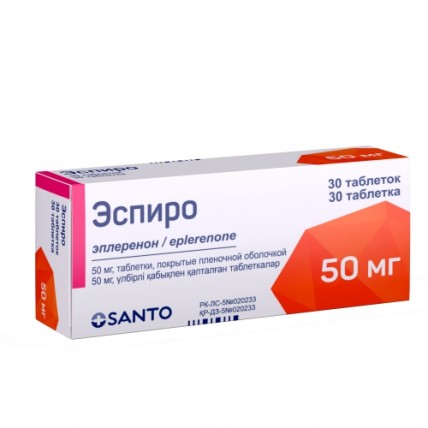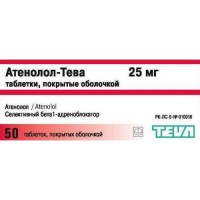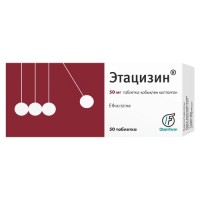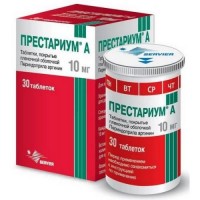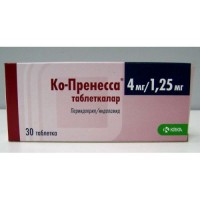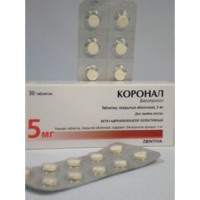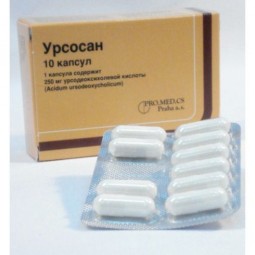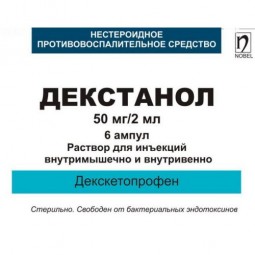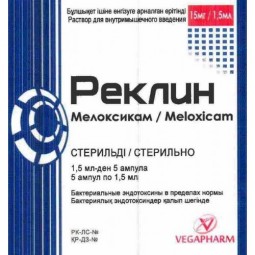Espirit 30s 50 mg film-coated tablets
- $50.40
The instruction for medical use of Espiro Torgovoye medicine Espiro Mezhdunarodnoye's name the unlicensed name Eplerenon Lekarstvennaya the Tablet form, film coated, 25 mg, 50 mg Structure One tablet contains active agent – an eplerenon of 25.0 mg or 50.0 mg respectively, excipients: lactoses monohydrate, cellulose microcrystalline, gipromelloza, sodium lauryl sulfate, croscarmellose sodium, magnesium stearate, structure of a cover of Opadray yellow 33G32578, including: gipromelloza, titan dioxide (E 171), lactoses monohydrate, macrogoal, triacetin, gland (III) oxide yellow (E 172). The description of the Tablet of round shape with a biconvex surface, film coated yellow color (for a dosage of 25 mg). Tablets of round shape with a biconvex surface, film coated yellow color on one party is available dividing risk (for a dosage of 50 mg). Pharmacotherapeutic group Kaliysberegayushchy diuretics. Antagonists of Aldosteronum. Eplerenon. ATH C03DA04 code the Pharmacological Pharmacokinetics Absorption properties and distribution the Absolute bioavailability of an eplerenon is not known. The maximum concentration in blood plasma is reached approximately in 2 h after use. The maximum concentration in blood plasma (Cmax) and the area under a curve of concentration (AUC) are proportional to a dose in the range of 10 - 100 mg and are less proportional at use in doses over 100 mg. Equilibrium concentration is reached for 2 days. Meal does not influence absorption. Linking of an eplerenon with proteins of blood plasma makes about 50%, mainly due to binding with an alpha 1-acid glycoproteins. The seeming distribution volume in an equilibrium state is 50 (±7) l. Eplerenon does not possess selective linking with erythrocytes. Metabolism and removal Metabolism of an eplerenon is carried out under the influence of an isoenzyme of CYP3A4 of P-450 cytochrome. Active metabolites of an eplerenon in blood plasma of the person are not identified. Less than 5% of a dose of an eplerenon are removed in not changed view with urine and a stake. After single dose in a dose of medicine, marked radioactive isotope, about 32% of a dose were removed with a stake and about 67% — with urine. Elimination half-life in a phase of elimination of an eplerenon makes about 3 - 5 hours. The clearance in blood plasma is about 10 l/h. Special groups of patients Age, sex and race: The pharmacokinetics of an eplerenon at men and women significantly did not differ. Elderly people have equilibrium indicators of Cmax (22%) and AUC (45%) were increased in comparison with young patients (18 - 45 years). Equilibrium indicators of Cmax and AUC at persons of negroid race were reduced respectively by 19 and 26%. Renal failure: The pharmacokinetics of an eplerenon was studied at patients with a renal failure of varying severity and at the patients who are on a hemodialysis. In comparison with healthy patients, equilibrium indicators of AUC and Cmax increased respectively by 38 and 24% at patients with a heavy renal failure, and decreased respectively by 26 and 3% at the patients who are on a hemodialysis. The correlation between clearance of an eplerenon from blood plasma and clearance of creatinine is not revealed. Eplerenon does not leave at a hemodialysis. Liver failure: At patients with a heavy liver failure eplerenon it was not studied therefore its use in this group of patients is contraindicated. Heart failure: The clearance of an eplerenon at patients with heart failure is similar to that at healthy faces. The pharmacodynamics Eplerenon has relative selectivity concerning mineralokortikoidny receptors at the person in comparison with glucocorticoid, progesterone and androgenic receptors, blocks their linking with Aldosteronum - key hormone the system renin-angiotensin-aldosteronovoy (SRAA) which takes part in regulation of arterial blood pressure and pathogenesis of cardiovascular diseases. Eplerenon causes permanent increase in levels of renin in plasma of blood and Aldosteronum in blood serum. Subsequently secretion of renin is suppressed with Aldosteronum on a feedback mechanism. At the same time increase in activity of renin or level of the circulating Aldosteronum does not affect effects of an eplerenon. Indications - as an additional tool to standard therapy using beta blockers, for the purpose of reduction of risk of mortality and cardiovascular incidence at patients with a stable clinical state with dysfunction of a left ventricle of heart (LVEF
of ≤40%) - for the purpose of reduction of risk of mortality and cardiovascular incidence at patients with clinical manifestations of heart failure after recently postponed myocardial infarction. The route of administration and Espiro's doses can be accepted in time or irrespective of meal. The recommended maintenance dose of Espiro makes 50 mg once a day. The maximum daily dose – 50 mg. For the purpose of reduction of risk of mortality and cardiovascular incidence at patients with clinical manifestations of heart failure after recently postponed myocardial infarction Treatment it is necessary to begin with a dose 25 mg once a day and to gradually increase it, it is the best of all within 4 weeks, before achievement of a necessary dose of 50 mg once a day, controlling potassium level in blood serum (watch Table 1). Usually it is reasonable to begin Espiro's treatment within 3-14 days after diagnosing of a myocardial infarction. For the purpose of reduction of risk of mortality and cardiovascular incidence at patients with a stable clinical state with dysfunction of a left ventricle of heart (LVEF
of ≤40%) In chronic heart failure (class II NYHA) treatment begin with a dose 25 mg once a day and gradually increase it, it is the best of all within 4 weeks, before achievement of a necessary dose of 50 mg once a day, controlling potassium level in blood serum (watch Table 1). Patients at whom potassium concentration in blood serum makes also gt, 5.0 mmol/l are not recommended to begin Espiro's treatment. Potassium level in blood serum should be determined prior to drug treatment, within the first week and in one month after the beginning of use or dose adjustment. Further potassium level in blood serum should be controlled periodically, as required. After the beginning of therapy the dose should be adjusted taking into account potassium level in blood serum as it is specified in the table. Potassium level in blood serum (mmol/l) Action Dose adjustment & lt, 5.0 to Increase 25 mg every other day to 25 mg 25 mg up to 50 mg 5.0-5.4 once a day once a day once a day to Keep Without change of a dose 5.5-5.9 to Lower 50 mg once a day to 25 mg once a day 25 mg once a day up to 25 mg every other day of 25 mg every other day before cancellation ≥6.0 to Cancel It is inapplicable At Espiro's cancellation because of increase in potassium concentration in blood serum ≥ 6.0 mmol/l, repeated use of drug in a dose of 25 mg perhaps every other day in case potassium concentration in blood serum makes less than 5.0 mmol/l. Use for children and teenagers Is not present data on use of an eplerenon for children therefore use of a medicinal product in this group of patients is not recommended. Use for elderly people of Correction of an initial dose for elderly people is not required. Owing to the deterioration in function of kidneys connected with age, risk of development of a hyperpotassemia at elderly people is higher. It can increase in addition in connection with associated diseases which increase concentration of a medicinal product in an organism, especially slight or moderate abnormal liver function. It is recommended to control periodically potassium level in blood serum. Use for patients with a renal failure of Correction of an initial dose with a slight renal failure is not required from patients. It is recommended to control periodically potassium level in blood serum. Eplerenon does not leave by means of dialysis. Use for patients with a liver failure of Correction of an initial dose with a slight or moderate abnormal liver function is not required from patients. Considering increase in concentration of an eplerenon in an organism of such patients, it is recommended to control often and regularly potassium concentration in blood serum, especially at patients of advanced age. Use for the patients taking other medicines At simultaneous use of weak or moderate CYP3A4 inhibitors, e.g., of Amiodaronum, diltiazem and verapamil, treatment it is necessary to begin with a dose 25 mg once a day. The dose should not exceed 25 mg once a day. Side effects Often (≥1/100 to & lt, 1/10) - infections - a hyperpotassemia - dizziness, a syncope - arterial hypotension - cough - diarrhea, nausea, a constipation - rash, an itching - a renal failure Infrequently (& gt, 1/1,000 to & lt, 1/100) - pyelonephritis - an eosinophilia - a hypothyroidism - a hyponatremia, dehydration, a hypercholesterolemia, a gipertriglitseridemiya - insomnia - a headache, a hypesthesia - a myocardial infarction, left ventricular heart failure, fibrillation of auricles, tachycardia - thrombosis of arteries of the lower extremities, orthostatic hypotension - pharyngitis - vomiting, a meteorism - the increased sweating - a dorsodynia, painful spasms of gastrocnemius muscles - cholecystitis - a gynecomastia - an asthenia, an indisposition - increase in level of urea nitrogen, creatinine, glucose in blood, decrease in level of a receptor of an epidermal growth factor. Frequency is not known - a Quincke's disease of the Contraindication - hypersensitivity to an eplerenon or any excipient of drug - potassium level in serum prior to treatment & gt, 5.0 mmol/l - a moderate and heavy renal failure (clearance of creatinine & lt, 30 ml/min.) - a heavy liver failure (class C for a scale of Chayld-Pyyu) - simultaneous use of kaliysberegayushchy diuretics, drugs of potassium or powerful CYP3A4 inhibitors (e.g., itrakonazol, ketokonazol, ritonavir, nelfinavir, klaritromitsin, telitromitsin and nefazodon) - in a combination with inhibitors of angiotensin-converting enzyme (APF) and antagonists of receptors of angiotensin II (APAII) - children's age up to 18 years - pregnancy, the lactation period Medicinal interactions Kaliysberegayushchy diuretics and drugs of potassium: Considering the increased risk of development of a hyperpotassemia, the patients receiving kaliysberegayushchy diuretics and drugs of potassium should not appoint Espiro. Kaliysberegayushchy diuretics can enhance effects of antihypertensive medicines and other diuretics. Lithium: Espiro's interaction with lithium was not studied, however intoxication cases by lithium at the patients who are at the same time receiving diuretics and inhibitors of angiotensin-converting enzyme are recorded. It is necessary to avoid simultaneous use of Espiro and lithium. If such treatment is necessary, it is necessary to control lithium level in blood plasma. Cyclosporine, takrolimus: Cyclosporine and takrolimus can be led to a renal failure and increase risk of a hyperpotassemia. It is necessary to avoid simultaneous use of Espiro and cyclosporine or a takrolimus. In case of need purposes of such treatment it is recommended to control carefully potassium level in blood serum and function of kidneys. Nonsteroid anti-inflammatory medicines (NPVP): Treatment of NPVP can lead to the acute renal failure caused by direct impact of these medicines on glomerular filtration, especially in patients from risk groups (patients of advanced age and (or) the dehydrated patients). The patients receiving Espiro and NPVP it is necessary to hydrate adequately, they need to carry out control of function of kidneys prior to treatment. Trimethoprimum: Simultaneous use of Trimethoprimum and Espiro increases risk of a hyperpotassemia. It is necessary to control potassium level in blood serum and function of kidneys, especially at patients with a renal failure and elderly people. Inhibitors of the angiotensin-converting enzyme (ACE), antagonists of receptors of angiotensin II (APAII): It is necessary to be careful at simultaneous use of Espiro and APF inhibitors or antagonists of receptors of angiotensin II. Espiro's combination with these medicines can increase risk of development of a hyperpotassemia at patients with risk of a renal failure, for example, of elderly people. Careful monitoring of level of potassium of serum and function of kidneys is recommended. Alpha 1 - adrenoblockers (e.g., Prazozinum, alfuzozin): At simultaneous use alpha 1 - adrenoblockers and Espiro there is a probability of increase in hypotensive effect and (or) orthostatic hypotension. During simultaneous use of Espiro and alfa-1-adrenoblockers clinical monitoring of orthostatic hypotension is recommended. Tricyclic antidepressants, neuroleptics, amifostin, Baclofenum: Simultaneous use of these medicines with Espiro can increase hypotensive effect and risk of orthostatic hypotension. Glucocorticosteroids, tetrakozaktid: Simultaneous use of these medicines with Espiro can lead to easing of antihypertensive effect (delay of sodium and liquid). Digoxin: Concentration of digoxin in an organism (AUC) at simultaneous use with Espiro increases by 16% (90% a confidence interval: 4% - 30%). It is necessary to be careful during use of digoxin in the doses close to the upper bound of therapeutic range. Warfarin: Clinically significant pharmacokinetic interactions with warfarin are not revealed. It is necessary to be careful during use of warfarin in the doses close to the upper bound of therapeutic range. CYP3A4 substrates: Results of pharmacokinetic researches with test CYP3A4 substrates, i.e. midazolam and tsizapridy, did not find signs of significant pharmacokinetic interactions at simultaneous use with Espiro. CYP3A4 inhibitors: Powerful CYP3A4 inhibitors: Significant pharmacokinetic interactions can be noted at simultaneous use of Espiro with CYP3A4 enzyme inhibitors. Powerful CYP3A4 inhibitor (ketokonazol 200 mg two times a day) caused increase in AUC of Espiro by 441%. Simultaneous use of Espiro with powerful CYP3A4 inhibitors, such, as ketokonazol, itrakonazol, ritonavir, nelfinavir, klaritromitsin, telitromitsin and nefazodon, contraindicated. Weak or moderate CYP3A4 inhibitors: Simultaneous use of Espiro with erythromycin, sakvinaviry, Amiodaronum, diltiazem, verapamil and flukonazoly caused significant pharmacokinetic interactions, the shown increase in AUC of Espiro by 98 - 187%. The daily dose of Espiro at simultaneous use of weak or moderate CYP3A4 inhibitors should not prevyshat25 to mg. Inductors CYP3A4: The concomitant use of tincture of a St. John's wort (powerful inductor CYP3A4) with Espiro caused decrease in AUC of the last by 30%. At use of more powerful inductors CYP3A4, such as rifampicin, perhaps more significant decrease Espiro's AUC. Considering possible decrease in efficiency of Espiro, simultaneous use of the powerful inductors CYP3A4 (rifampicin, carbamazepine, Phenytoinum, phenobarbital, St. John's wort tincture) and Espiro is not recommended. Antacids: On the basis of results of pharmacokinetic clinical trial of significant interactions of antacids with Espiro at their simultaneous use it is not supposed. The special instructions Hyperpotassemia At Espiro's use the hyperpotassemia caused by his mechanism of action can develop. In an initiation of treatment and at change of a dose of drug at all patients it is necessary to control potassium concentration in blood serum. During further treatment the periodic control of potassium concentration is especially recommended to be carried out at patients with the increased risk of development of a hyperpotassemia, such as elderly patients with a renal failure and patients with diabetes. Considering the increased risk of development of a hyperpotassemia, use of drugs of potassium after an initiation of treatment of Espiro it is not recommended. It is proved that the dose decline of Espiro leads to decrease in potassium concentration in blood serum. In one research it is proved that administration of Hydrochlorthiazidum against the background of Espiro's treatment interferes with increase in potassium concentration in blood serum. Dysfunction on
EC: At patients with a renal failure, including a diabetic microalbuminuria, it is regularly recommended to control potassium concentration in blood serum. Risk of development of a hyperpotassemia increases at depression of function of kidneys. Espiro does not leave by means of a hemodialysis. Abnormal liver function: At patients with a slight or moderate abnormal liver function (class A and B on a scale of Chayld-Pyyu) increases in potassium concentration in blood serum more than 5.5 mmol/l were not revealed. At such patients it is necessary to control the level of electrolytes. At patients with a heavy abnormal liver function Espiro's use was not studied therefore his appointment is contraindicated. Lactose: Tablets contain lactose therefore patients should not appoint them with rare hereditary intolerance of a galactose, a lactose intolerance of Lapp or a sprue of glucose galactose. Pregnancy and the period of a lactation of Researches on Espiro's use during pregnancy and a lactation it was not carried out. In case of need drug uses the decision on its appointment is made by the doctor when the expected advantage for mother considerably exceeds possible risk for the fruit/child. It is necessary to appoint eplerenon to pregnant women with care. Feeding by a breast: It is unknown whether it is allocated eplerenon with breast milk after intake. Considering that possible undesirable effects at the newborn who is on breastfeeding are unknown, it is necessary to consider expediency of the termination of feeding by a breast or medicine cancellations, depending on importance of its use for the patient. Features of influence of medicine on ability to run the vehicle or potentially dangerous mechanisms Data on Espiro's influence on ability to control of vehicles and to service of moving mechanisms are absent. Eplerenon does not cause drowsiness or disturbance of cognitive functions, but at control of vehicles or service of mechanisms it is necessary to consider a possibility of appearance of dizziness during treatment. Overdose of Cases of overdose of Espiro it is not described. Symptoms: hyperpotassemia, hypotension. Treatment: prescribing of activated carbon and symptomatic therapy. The hemodialysis is not effective. A form of release and packing On 10 or 14 tablets in blister strip packaging from a film polyvinylchloride or PVDC and aluminum foil. On 1, 2, 3, 5 or 9 blister strip packagings on 10 tablets or on 2 planimetric packs on 14 tablets together with the approved instruction for medical use in the state and Russian languages in a pack from cardboard. To Store storage conditions at a temperature not above 25 °C. To store out of children's reach! 2 years not to apply a period of storage after an expiration date. Prescription status According to the prescription the Producer the Pharmaceutical plant JSC Polfarm, Poland of st. of Pelplinsk 19, 83-200 Starogard Gdanski the Owner of the registration certificate of JSC Khimfarm
to Develop Kazakhstan
of ≤40%) - for the purpose of reduction of risk of mortality and cardiovascular incidence at patients with clinical manifestations of heart failure after recently postponed myocardial infarction. The route of administration and Espiro's doses can be accepted in time or irrespective of meal. The recommended maintenance dose of Espiro makes 50 mg once a day. The maximum daily dose – 50 mg. For the purpose of reduction of risk of mortality and cardiovascular incidence at patients with clinical manifestations of heart failure after recently postponed myocardial infarction Treatment it is necessary to begin with a dose 25 mg once a day and to gradually increase it, it is the best of all within 4 weeks, before achievement of a necessary dose of 50 mg once a day, controlling potassium level in blood serum (watch Table 1). Usually it is reasonable to begin Espiro's treatment within 3-14 days after diagnosing of a myocardial infarction. For the purpose of reduction of risk of mortality and cardiovascular incidence at patients with a stable clinical state with dysfunction of a left ventricle of heart (LVEF
of ≤40%) In chronic heart failure (class II NYHA) treatment begin with a dose 25 mg once a day and gradually increase it, it is the best of all within 4 weeks, before achievement of a necessary dose of 50 mg once a day, controlling potassium level in blood serum (watch Table 1). Patients at whom potassium concentration in blood serum makes also gt, 5.0 mmol/l are not recommended to begin Espiro's treatment. Potassium level in blood serum should be determined prior to drug treatment, within the first week and in one month after the beginning of use or dose adjustment. Further potassium level in blood serum should be controlled periodically, as required. After the beginning of therapy the dose should be adjusted taking into account potassium level in blood serum as it is specified in the table. Potassium level in blood serum (mmol/l) Action Dose adjustment & lt, 5.0 to Increase 25 mg every other day to 25 mg 25 mg up to 50 mg 5.0-5.4 once a day once a day once a day to Keep Without change of a dose 5.5-5.9 to Lower 50 mg once a day to 25 mg once a day 25 mg once a day up to 25 mg every other day of 25 mg every other day before cancellation ≥6.0 to Cancel It is inapplicable At Espiro's cancellation because of increase in potassium concentration in blood serum ≥ 6.0 mmol/l, repeated use of drug in a dose of 25 mg perhaps every other day in case potassium concentration in blood serum makes less than 5.0 mmol/l. Use for children and teenagers Is not present data on use of an eplerenon for children therefore use of a medicinal product in this group of patients is not recommended. Use for elderly people of Correction of an initial dose for elderly people is not required. Owing to the deterioration in function of kidneys connected with age, risk of development of a hyperpotassemia at elderly people is higher. It can increase in addition in connection with associated diseases which increase concentration of a medicinal product in an organism, especially slight or moderate abnormal liver function. It is recommended to control periodically potassium level in blood serum. Use for patients with a renal failure of Correction of an initial dose with a slight renal failure is not required from patients. It is recommended to control periodically potassium level in blood serum. Eplerenon does not leave by means of dialysis. Use for patients with a liver failure of Correction of an initial dose with a slight or moderate abnormal liver function is not required from patients. Considering increase in concentration of an eplerenon in an organism of such patients, it is recommended to control often and regularly potassium concentration in blood serum, especially at patients of advanced age. Use for the patients taking other medicines At simultaneous use of weak or moderate CYP3A4 inhibitors, e.g., of Amiodaronum, diltiazem and verapamil, treatment it is necessary to begin with a dose 25 mg once a day. The dose should not exceed 25 mg once a day. Side effects Often (≥1/100 to & lt, 1/10) - infections - a hyperpotassemia - dizziness, a syncope - arterial hypotension - cough - diarrhea, nausea, a constipation - rash, an itching - a renal failure Infrequently (& gt, 1/1,000 to & lt, 1/100) - pyelonephritis - an eosinophilia - a hypothyroidism - a hyponatremia, dehydration, a hypercholesterolemia, a gipertriglitseridemiya - insomnia - a headache, a hypesthesia - a myocardial infarction, left ventricular heart failure, fibrillation of auricles, tachycardia - thrombosis of arteries of the lower extremities, orthostatic hypotension - pharyngitis - vomiting, a meteorism - the increased sweating - a dorsodynia, painful spasms of gastrocnemius muscles - cholecystitis - a gynecomastia - an asthenia, an indisposition - increase in level of urea nitrogen, creatinine, glucose in blood, decrease in level of a receptor of an epidermal growth factor. Frequency is not known - a Quincke's disease of the Contraindication - hypersensitivity to an eplerenon or any excipient of drug - potassium level in serum prior to treatment & gt, 5.0 mmol/l - a moderate and heavy renal failure (clearance of creatinine & lt, 30 ml/min.) - a heavy liver failure (class C for a scale of Chayld-Pyyu) - simultaneous use of kaliysberegayushchy diuretics, drugs of potassium or powerful CYP3A4 inhibitors (e.g., itrakonazol, ketokonazol, ritonavir, nelfinavir, klaritromitsin, telitromitsin and nefazodon) - in a combination with inhibitors of angiotensin-converting enzyme (APF) and antagonists of receptors of angiotensin II (APAII) - children's age up to 18 years - pregnancy, the lactation period Medicinal interactions Kaliysberegayushchy diuretics and drugs of potassium: Considering the increased risk of development of a hyperpotassemia, the patients receiving kaliysberegayushchy diuretics and drugs of potassium should not appoint Espiro. Kaliysberegayushchy diuretics can enhance effects of antihypertensive medicines and other diuretics. Lithium: Espiro's interaction with lithium was not studied, however intoxication cases by lithium at the patients who are at the same time receiving diuretics and inhibitors of angiotensin-converting enzyme are recorded. It is necessary to avoid simultaneous use of Espiro and lithium. If such treatment is necessary, it is necessary to control lithium level in blood plasma. Cyclosporine, takrolimus: Cyclosporine and takrolimus can be led to a renal failure and increase risk of a hyperpotassemia. It is necessary to avoid simultaneous use of Espiro and cyclosporine or a takrolimus. In case of need purposes of such treatment it is recommended to control carefully potassium level in blood serum and function of kidneys. Nonsteroid anti-inflammatory medicines (NPVP): Treatment of NPVP can lead to the acute renal failure caused by direct impact of these medicines on glomerular filtration, especially in patients from risk groups (patients of advanced age and (or) the dehydrated patients). The patients receiving Espiro and NPVP it is necessary to hydrate adequately, they need to carry out control of function of kidneys prior to treatment. Trimethoprimum: Simultaneous use of Trimethoprimum and Espiro increases risk of a hyperpotassemia. It is necessary to control potassium level in blood serum and function of kidneys, especially at patients with a renal failure and elderly people. Inhibitors of the angiotensin-converting enzyme (ACE), antagonists of receptors of angiotensin II (APAII): It is necessary to be careful at simultaneous use of Espiro and APF inhibitors or antagonists of receptors of angiotensin II. Espiro's combination with these medicines can increase risk of development of a hyperpotassemia at patients with risk of a renal failure, for example, of elderly people. Careful monitoring of level of potassium of serum and function of kidneys is recommended. Alpha 1 - adrenoblockers (e.g., Prazozinum, alfuzozin): At simultaneous use alpha 1 - adrenoblockers and Espiro there is a probability of increase in hypotensive effect and (or) orthostatic hypotension. During simultaneous use of Espiro and alfa-1-adrenoblockers clinical monitoring of orthostatic hypotension is recommended. Tricyclic antidepressants, neuroleptics, amifostin, Baclofenum: Simultaneous use of these medicines with Espiro can increase hypotensive effect and risk of orthostatic hypotension. Glucocorticosteroids, tetrakozaktid: Simultaneous use of these medicines with Espiro can lead to easing of antihypertensive effect (delay of sodium and liquid). Digoxin: Concentration of digoxin in an organism (AUC) at simultaneous use with Espiro increases by 16% (90% a confidence interval: 4% - 30%). It is necessary to be careful during use of digoxin in the doses close to the upper bound of therapeutic range. Warfarin: Clinically significant pharmacokinetic interactions with warfarin are not revealed. It is necessary to be careful during use of warfarin in the doses close to the upper bound of therapeutic range. CYP3A4 substrates: Results of pharmacokinetic researches with test CYP3A4 substrates, i.e. midazolam and tsizapridy, did not find signs of significant pharmacokinetic interactions at simultaneous use with Espiro. CYP3A4 inhibitors: Powerful CYP3A4 inhibitors: Significant pharmacokinetic interactions can be noted at simultaneous use of Espiro with CYP3A4 enzyme inhibitors. Powerful CYP3A4 inhibitor (ketokonazol 200 mg two times a day) caused increase in AUC of Espiro by 441%. Simultaneous use of Espiro with powerful CYP3A4 inhibitors, such, as ketokonazol, itrakonazol, ritonavir, nelfinavir, klaritromitsin, telitromitsin and nefazodon, contraindicated. Weak or moderate CYP3A4 inhibitors: Simultaneous use of Espiro with erythromycin, sakvinaviry, Amiodaronum, diltiazem, verapamil and flukonazoly caused significant pharmacokinetic interactions, the shown increase in AUC of Espiro by 98 - 187%. The daily dose of Espiro at simultaneous use of weak or moderate CYP3A4 inhibitors should not prevyshat25 to mg. Inductors CYP3A4: The concomitant use of tincture of a St. John's wort (powerful inductor CYP3A4) with Espiro caused decrease in AUC of the last by 30%. At use of more powerful inductors CYP3A4, such as rifampicin, perhaps more significant decrease Espiro's AUC. Considering possible decrease in efficiency of Espiro, simultaneous use of the powerful inductors CYP3A4 (rifampicin, carbamazepine, Phenytoinum, phenobarbital, St. John's wort tincture) and Espiro is not recommended. Antacids: On the basis of results of pharmacokinetic clinical trial of significant interactions of antacids with Espiro at their simultaneous use it is not supposed. The special instructions Hyperpotassemia At Espiro's use the hyperpotassemia caused by his mechanism of action can develop. In an initiation of treatment and at change of a dose of drug at all patients it is necessary to control potassium concentration in blood serum. During further treatment the periodic control of potassium concentration is especially recommended to be carried out at patients with the increased risk of development of a hyperpotassemia, such as elderly patients with a renal failure and patients with diabetes. Considering the increased risk of development of a hyperpotassemia, use of drugs of potassium after an initiation of treatment of Espiro it is not recommended. It is proved that the dose decline of Espiro leads to decrease in potassium concentration in blood serum. In one research it is proved that administration of Hydrochlorthiazidum against the background of Espiro's treatment interferes with increase in potassium concentration in blood serum. Dysfunction on
EC: At patients with a renal failure, including a diabetic microalbuminuria, it is regularly recommended to control potassium concentration in blood serum. Risk of development of a hyperpotassemia increases at depression of function of kidneys. Espiro does not leave by means of a hemodialysis. Abnormal liver function: At patients with a slight or moderate abnormal liver function (class A and B on a scale of Chayld-Pyyu) increases in potassium concentration in blood serum more than 5.5 mmol/l were not revealed. At such patients it is necessary to control the level of electrolytes. At patients with a heavy abnormal liver function Espiro's use was not studied therefore his appointment is contraindicated. Lactose: Tablets contain lactose therefore patients should not appoint them with rare hereditary intolerance of a galactose, a lactose intolerance of Lapp or a sprue of glucose galactose. Pregnancy and the period of a lactation of Researches on Espiro's use during pregnancy and a lactation it was not carried out. In case of need drug uses the decision on its appointment is made by the doctor when the expected advantage for mother considerably exceeds possible risk for the fruit/child. It is necessary to appoint eplerenon to pregnant women with care. Feeding by a breast: It is unknown whether it is allocated eplerenon with breast milk after intake. Considering that possible undesirable effects at the newborn who is on breastfeeding are unknown, it is necessary to consider expediency of the termination of feeding by a breast or medicine cancellations, depending on importance of its use for the patient. Features of influence of medicine on ability to run the vehicle or potentially dangerous mechanisms Data on Espiro's influence on ability to control of vehicles and to service of moving mechanisms are absent. Eplerenon does not cause drowsiness or disturbance of cognitive functions, but at control of vehicles or service of mechanisms it is necessary to consider a possibility of appearance of dizziness during treatment. Overdose of Cases of overdose of Espiro it is not described. Symptoms: hyperpotassemia, hypotension. Treatment: prescribing of activated carbon and symptomatic therapy. The hemodialysis is not effective. A form of release and packing On 10 or 14 tablets in blister strip packaging from a film polyvinylchloride or PVDC and aluminum foil. On 1, 2, 3, 5 or 9 blister strip packagings on 10 tablets or on 2 planimetric packs on 14 tablets together with the approved instruction for medical use in the state and Russian languages in a pack from cardboard. To Store storage conditions at a temperature not above 25 °C. To store out of children's reach! 2 years not to apply a period of storage after an expiration date. Prescription status According to the prescription the Producer the Pharmaceutical plant JSC Polfarm, Poland of st. of Pelplinsk 19, 83-200 Starogard Gdanski the Owner of the registration certificate of JSC Khimfarm
to Develop Kazakhstan
